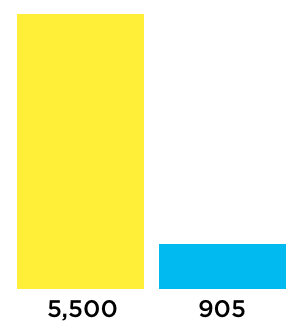Pittsburgh Leads in Parking Payment Technology
Parking Problems
Implementing a pay-by-plate solution involves numerous technical and cultural challenges, as the Pittsburgh Parking Authority can attest. Here are some issues that officials faced and how they coped:

Preplanning is critical. Before implementation, the IT team took time to upgrade the infrastructure, assess the reality of cellular coverage, mobilize the enforcement workforce and hire a Gtechna development team to enable requisite server communications capabilities.

There's no such thing as overnight success. After initial training, IT Administrator Philip True Savino and his team rolled out new wireless handheld devices to groups of 10 enforcement officers at a time so they could adjust to the new process.

Most will love it … but not everyone. Members of the general public who are less comfortable with technology will be intimidated by the change. To counter this, Pittsburgh posted an instructional video on the city website, published a brochure of frequently asked questions and attended numerous neighborhood and business gatherings to explain the benefits of the automated system.

Not-so-total recall. The alphanumeric codes that make up license plates aren't typically logical so they may be difficult to memorize. As an aid, the Pittsburgh Parking Authority provides drivers with a keychain fob resembling a blank Pennsylvania license plate that drivers can fill in with a marker and keep on hand.
Last year, Pittsburgh officials were eager to follow the lead of other major cities that had successfully replaced antiquated parking meters with automated multispace parking kiosks.
A familiar part of the local streetscape for nearly 75 years, the Steel City's coin-operated single-space meters were still operable, but difficult to support. "We were short on resources to continually empty the coin boxes when they were full, so we were dealing with excessive jamming and repair requirements, along with frustrated customers and lost revenue," says Philip True Savino, until recently an IT administrator and now a consultant for the Pittsburgh Parking Authority (PPA). Nor did the meters accept credit cards, which customers expect to be able to use as a payment method for routine transactions.
Savino and a special project team envisioned more than simply overcoming these problems, however. They wanted to deploy an automated solution to increase revenue, improve the organization's efficiency, effectiveness and transparency, and take advantage of other emerging technologies.
Pay-by-Plate Simplifies Parking and Enforcement
Last July, Pittsburgh became the first in the country to implement a citywide pay-by-plate parking system.
Pay-by-plate technology allows motorists to input their vehicle license plate number into a payment kiosk instead of requiring a parking space number or paper receipt.
"Pay-by-plate ties together and centralizes both the parking technology and the enforcement technology with a unique identifier, which is that license plate," Savino explains. "As a result, we can use that unique identifier to track transactions, verify and enforce parking compliance and pull together parking reports in real time."
Savino outfitted parking enforcement officers with Honeywell Dolphin 99EX cellular handheld devices. The officers type in a plate number and connect to a back-end server running Gtechna enforcement management software to check the vehicle's payment status. If the database shows no record of payment for that plate number, or time has expired, the officer can electronically log the violation, print a paper ticket and place it on the windshield.
Fewer Tickets, Less Frustration, Increased Revenue
In the first five months of operation, the pay-by-plate solution has boosted the Pittsburgh Parking Authority's coffers by nearly 60 percent, despite the fact that officers have actually been writing fewer tickets.
"Now that drivers have the capability to use credit cards, they're no longer willing to gamble on running into the coffee shop without feeding the meter," surmises Jason Phillips, an enforcement supervisor for the Parking Authority. "When it was coin-driven, if people didn't have quarters in their pocket, they would take that risk."
The payment kiosk also has a built-in alerting capability so officials will know immediately if it is out of paper or in need of repair. And if the kiosk is out of order for any length of time, officials can reprogram it to direct drivers to pay at another kiosk on the block. "We don't have to lose that revenue because of a broken meter," Phillips says.
In fact, the convenience, flexibility and transparency that the system provides are making for happier, less frustrated parking patrons, says Savino.
For example, if parkers get delayed downtown and their meter is set to expire, they can stop at any convenient kiosk in that zone and pay for additional parking time rather than having to rush back to their vehicle to avoid a ticket. And because the parking kiosk provides printed payment receipts and the system maintains an archive of transactions, "both the parker and the Parking Authority each have more concrete evidence if there's ever any dispute," Savino explains.

Pittsburgh replaced 5,500 coin-operated, single-space street meters with 905 multispace parking kiosks.
Enforcement officers are also able to cover more and better ground, Phillips says. "Reports can determine which areas are most in need of enforcement on those days when we might not be able to cover every single portion of the city, and then target the areas that indicate the least compliance."
The Future of Parking
The pay-by-plate method also sets the stage for future enhancements. For example, Pittsburgh is moving ahead with plans to utilize license plate recognition (LPR) technology. Three parking enforcement vehicles will soon gain roof-mounted cameras and computing hardware that can scan license plates of vehicles parked on the street and query the enforcement server for real-time payment data.
"In a matter of a minute, we'll be able to enforce the whole block — a task that previously may have taken 10 minutes or more to do on foot," says Savino. If Pittsburgh wishes to, it can also adopt LPR capability for enforcement in city-owned and operated garages and parking lots.
What's more, the Parking Authority hopes to roll out pay-by-phone, which will allow drivers to download a mobile app to register their plate number and credit card number and pay for parking from wherever they happen to be.
By adopting a pay-by-plate system, Pittsburgh is now paving the way for other municipalities. "We're being looked at and studied," Savino says. "Several cities that have talked to us are now moving to this type of solution because they've seen what we've been able to do."
Parking Options
Municipalities currently have three ways to program kiosk-based parking meters:
Pay and Display
When a parker purchases time for his or her vehicle using a credit card, the machine prints a receipt showing the location, amount paid, time entered and time of expiration, which must then be taken back to the vehicle and displayed on the dashboard to avoid a parking ticket.
- Pros: Simple and inexpensive to set up because it doesn't require investment in any other hardware or software.
- Cons: Inconvenient and time-consuming for motorists because they have to take their receipt back to the car and enforcement officers must take time to locate and read parking receipts to determine validity.
Pay by Space
This method requires drivers to take note of the parking space number and input it into the kiosk along with a credit card or other payment.
- Pros: Parkers can just pay and go. If equipped properly, enforcement officers can easily determine which spaces are paid and unpaid using a wireless handheld device.
- Cons: Motorists must remember to note the space number before going to the kiosk, and if they don't remember the number or make an input error, they'll get a ticket.
Pay by Plate
These machines keep track of multiple parking spaces by tying a vehicle owner's purchase of parking time to their vehicle's license plate number.
- Pros: Adds significant flexibility and convenience for parkers, who can move their car within the same zone without losing their paid-for time or purchase additional parking time from any kiosk in the city; improves enforcement efficiency and effectiveness; and can be used in tandem with emerging technologies, such as pay-by-phone and license plate recognition.
- Cons: Requires infrastructure upgrades and integration with back-end servers, use of wireless mobile enforcement devices and strong cellular coverage to maximize functionality.








